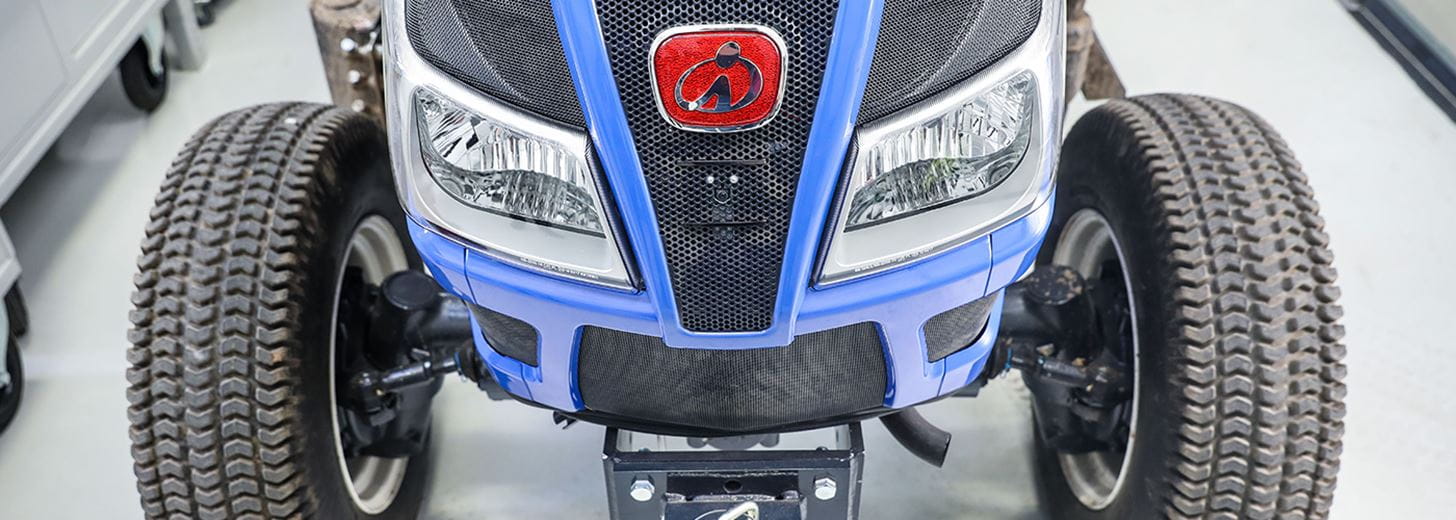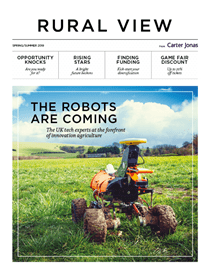What is smart farming? Smart Farming is the process of using modern technology such as automation and agricultural robots, to increase the quantity and quality of agricultural products. So, how long do you think it will be before an automated, mechanic workforce is farming your fields, rather than humans?
For many landowners, the answer is probably ‘not in my career’ or ‘never’. Try telling that to Harper Adams University’s Kit Franklin and Jonathan Gill who have proven not once, but twice, that it is possible to drill, grow and harvest a hectare of arable crops without a single person entering the field. The Hands Free Hectare is a remarkable achievement – a world first in smart farming, in fact – and it’s not stopping there. The pair harbour ambitions for a hands-free farm – an integrated environment where people and robots work in tandem to create an operation that’s as efficient as it is productive.
Like a lot of good ideas, their achievement was driven by frustration. They wanted to prove that a remote workforce was within touching distance and not a pipe dream. “When people talk about automation and robots in agriculture, a lot talk and think in terms of it being in 2050,” says Jonathan, a mechatronics researcher at the Shropshire University. “We got frustrated about that and wanted to show that there was nothing stopping us doing it today. The only way to prove it was to go and do it.” So that’s what they did. Funded by Precision Decisions and Innovate UK, plus backing in 2018 from AHDB, the team retro-fitted a small Iseki tractor and a 25-year-old Sampo combine with ‘linear actuators’ – a series of motors and levers allowing them to be operated remotely. A drone took the place of field-walking to assess crop health and identify where actions needed to be taken.
In 2017, they grew a 4.5-tonne crop of spring barley without a human entering the field and, after successfully proving the concept, returned to grow a 6.5-tonne crop of winter wheat in 2018, after focusing on improving machinery accuracy and coverage to boost yield. “We wanted to use standard agricultural machines which we modified in ways that are accessible to everyone using open source to do it,” Jonathan said. Satellites communicate with machinery to tell them where to go and what actions to take when they get to certain points. Following a breadcrumb trail of points across the field before lifting the combine header or turning the sprayer off are simple examples of how the technology works. “This is not pie-in-the-sky thinking,” Jonathan continued. “We have a 40hp tractor planting and spraying our crop the way you would do in conventional agriculture. By using an old, neglected combine we have been able to show that this technology can be added to anything. “There was this heart-warming moment when we had both vehicles running at the same time, harvesting and collecting, while we had drones flying over it.”
In year one of the project, the crop was grown using 10 standard agricultural applications, from drilling and herbicides to T2 fungicides and harvesting. “It was a fantastic achievement to complete the first harvest of the crop,” Jonathan said. “Once we completed it, we started again and focused on the improvements.” “We improved the yield by having less compaction and straighter lines in 2018 too,” he said. “It might not be a record-breaking yield but it was a record-breaking solution. Not even your big green or red tractors have grown a hands free crop like this.”
CHANGING AND CHALLENGING PERCEPTIONS
Perhaps the greatest achievement the Hands Free Hectare has had is contributing towards a change of mindset. Kit, a senior lecturer in agricultural engineering, said: “When you go out to farms now and ask about driverless tractors, people say they are probably 10 years away. The view used to be that it was 30 years away. “It’s almost become old news – of course driverless tractors are coming because it’s been proven. I think we can lay claim to a big chunk of that change in perception.” What isn’t clear is exactly what form the driverless fleet will take. From the outset of the project, Kit and Jonathan deliberately chose machines which would resonate with farmers to aid buy-in.
“My experience was that farmers switched off when you showed them a robot the size of a vacuum cleaner – they didn’t feel it would ever replace a tractor,” Kit said. “But they know we used to farm with smaller tractors, so that’s what we used, to keep it relatable.” For the team at The Small Robot Company, it’s no longer a question of ‘if’ but ‘when’ agricultural robots will be deployed into the farming and agribusiness industry.
“Today’s farm machinery is designed to carry a driver. As soon as you take out that requirement, you can put the engine and the implements wherever it is most efficient” says Jonathan. “Power output does not need to be in a certain place. The electric drive could be on the wheel, for example, and the implement may be more effective in the centre. “The tractor of the future may not look like a tractor. You can make something that’s refined for the job you want it to do. “That’s why I think it could be a company like Tesla or Dyson which breaks the mould. The major agricultural machinery manufacturers have huge amounts invested in tractors looking like tractors. Other companies can design it from scratch.” Whatever it looks like, the machines are expected to be smaller than the machinery used now. “There is a debate over what the optimum power output is but for us it’s probably between 40hp and 90hp,” Kit said.
WHAT’S THE REAL MOTIVATION?
“We didn’t just do it because I love robots,” Jonathan said. “I do love robots, but that’s not the point.” He says the motivation is the big picture of global food production – a rocketing population without the yield increases to match. While the solutions to many agricultural challenges appear to involve scaling up, the Hands Free Hectare team come at it from the opposite direction.
“Agriculture seems to deal with large, entire fields. Maybe some of us go into sub-field sections to deal with issues on a smaller scale, but we want to manage single plants on their own, giving the crop precisely what it needs whilst weeding or spot spraying” Kit said. “We wanted to grow in the best possible way, improving efficiencies and reducing waste. The only way to do it was with robots.” Jonathan added: “My personal belief is that current practices are driving us away from the soil at a time when we need to work closer to it.”
Harper Adams University has gained notoriety for its position at the cutting edge of agricultural technology, with the established Centre for Precision Farming Technology, pioneered by the now-retired Professor Simon Blackmore. The Hands Free Hectare is yet another string to the University’s bow, but Jonathan and Kit believe this is just the start. Jonathan said: “We want to show that this is not only achievable on a perfect hectare of land, we want to show that it can be applied anywhere.”
A hands free farm? “That would be a nice way to go,” he says with a smile. They hope to be ready to grow 30-40ha of crops in the 2020 season. Working towards that goal, the next phase of the team’s development is well underway, focusing on improving and refining the existing technology. “We’ve got a new Iseki tractor fitted with a tiny camera to the front of it. By using some funky software it’s able to recognise people and has been able to find up to 16 in one image, which is pretty special,” Kit explains. “The idea is nothing new – Microsoft had an Xbox which could do this 15 years ago but that was loaded with technology and worked indoors, whereas this is a £15 camera with adapted software, which has a variety of practical applications. “We are considering whether you could apply this to CCTV in the farmyard – if there is someone in the yard the machines won’t drive around.”
The work the pair are doing should prove that the machine can drive the 500m from the development laboratory, lift the gate to the trial hectare, carry out its work then return to home, all without a driver. The university is also acting as a testbed for 5G mobile signals, which will allow better data transfer for rural communities. Kit said: “As most farmers will know, connectivity is a massive issue and is one of the biggest barriers to delivering this sort of innovation on a large scale. But there are a number of advances being made with 5G and near earth satellite technologies which may circumvent a lot of the problems. We will see.”
Jonathan adds that projects such as the Hands Free Hectare have to look beyond the issues and push the boundaries of what’s possible. “We’re here at an agricultural university, we need to inspire. The next generation is coming through and they want to see what the future holds. We have a responsibility to show them what’s possible.”
To read more articles like the one above click the link below to download the full publication.
Inside this Spring/Summer 2019 edition of Rural View, you will find articles about crops being sown, grown and harvested without a single person entering the field, as well as an interview with the Small Robot Company, conversations with the next generation about the rapid pace of change and what this means for their careers, and how technology can be used to harness opportunities and make businesses more resilient, plus many more.
Latest news
- DEFRA has today opened the Improving Farm Productivity grant
- Carter Jonas Reports Half Year Results for 2020
- Carter Jonas Strengthens Rural South West Team With Senior Appointment
- Battery Energy Storage
- Carter Jonas signs-up to Time to Change initiative
- Raft of Promotions at Carter Jonas
- Carter Jonas Achieves Gold Investors In People Accreditation
- Newbury Straw Sale met with Selective Trade as Spring Approaches
- Newbury Straw Sale met with buoyant trade







